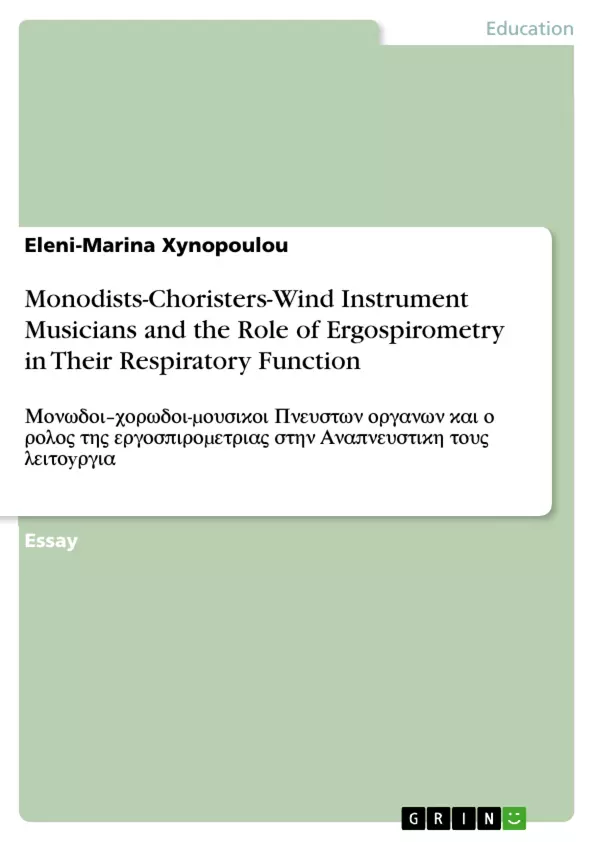It is said that "music calms the soul and heals the heart". When classical music singers and phonetics teachers wonder about "what it takes to sing well", the list of answers almost always begins with "good respiration". However, despite the hard, manifold work, there is still a big gap between the research on respiration while singing and its influence at the teaching studio.
There are three main reasons for this lack of interaction. First and foremost, phonetics teachers often think it is difficult to have access to the notions, techniques and equipment used in respiration studies. This lack of familiarization renders the performance and the application of research findings in the studio difficult. Secondly, the field of application of the "respiratory system", as it is considered, is often too narrow, neglecting the respiratory contribution of the elements directly connected with respiration. Finally, one perceiving respiration simply as a provision of air for phonation negates its role as a link between the phonation, the emotions and the music line, a role which is of vital importance for singing and its teaching. This had led some pedagogical approaches to cast away the studies as unrealistic.
Respiration has a central role as the intermediary between phonation, emotion and music. However, the teachers, who pleasantly discuss the parts, the singer's formant as well as the relationship between the thyroarytenoid muscle and the cricothyroid muscle, have nothing to say regarding recoil, the contribution of the chest volume or the exhalation level during repose. The analysis of the function of one of the body's systems can prove to be an extremely complicated procedure. Nowadays, powerful computers and cheap software offer phonetics teachers the chance to experience first-hand how these are related to their teaching and the singer standing in front of them. However, for the time being, the respiration measurement equipment is specialized, heavy and expensive and few teachers have the chance to use it in learning in an auxiliary way.
Inhaltsverzeichnis
- ΓΕΝΙΚΟ ΜΕΡΟΣ.
- ΕΙΣΑΓΩΓΗ
- ΚΕΦΑΛΑΙΟ 1. ΑΝΑΤΟΜΙΑ ΚΑΤΩΤΕΡΗΣ ΑΝΑΠΝΕΥΣΤΙΚΗΣ ΟΔΟΥ.
- 1.1 Τραχεία -Βρόγχοι
- 1.2 Πνεύμονες
- 1.4 Η λειτουργία των αναπνευστικών μυών και οι μεταβολές των πνευμόνων κατά τις αναπνευστικές κινήσεις .
- ΚΕΦΑΛΑΙΟ 2. Η ΦΥΣΙΟΛΟΓΙΑ ΤΗΣ ΑΝΑΠΝΟΗΣ
- 2.1 Η μηχανική του αερισμού των πνευμόνων
- 2.2 Το μηχανικό έργο της αναπνοής .
- 2.3 Η σπιρομέτρηση.
- 2.4 Η επίδραση της άσκησης στους μυς και στην απόδοσή τους...
- 2.4.1 Η σημασία της προπόνησης με άσκηση μέγιστης αντίστασης..
- 2.4.2 Η υπερτροφία των μυών.....
- 2.4.3 Η επίδραση του καπνίσματος στον αερισμό των πνευμόνων κατά τη μυϊκή δραστηριότητα.......
- ΚΕΦΑΛΑΙΟ 3. Η ΑΝΑΠΝΕΥΣΤΙΚΗ ΛΕΙΤΟΥΡΓΙΑ ΣΤΟΥΣ ΜΟΥΣΙΚΟΥΣ ΠΝΕΥΣΤΩΝ ΚΑΙ ΣΤΟΥΣ ΧΟΡΩΔΟΥΣ/ΜΟΝΩΔΟΥΣ
- 3.1 Γενικά ...
- 3.2 Μουσικοί πνευστών οργάνων .
- 3.3 Χορωδοί - μονωδοί..........\li>
- 3.4 Η ευεργετική επίδραση της μουσικής στις αναπνευστικές παθήσεις..\li>
- ΚΕΦΑΛΑΙΟ 4. ΕΡΓΟΣΠΙΡΟΜΕΤΡΙΑ
- ΕΙΔΙΚΟ ΜΕΡΟΣ
- ΚΕΦΑΛΑΙΟ 5. ΜΕΘΟΔΟΛΟΓΙΑ
- 5.1 Σκοπός.
- 5.2 Δείγμα και Διαδικασία
- ΚΕΦΑΛΑΙΟ 6. ΑΠΟΤΕΛΕΣΜΑΤΑ
- 6.1 ΠΕΙΡΑΜΑΤΙΚΗ ΟΜΑΔΑ
- 6.2 Εργοσπιρομετρία......
- ΚΕΦΑΛΑΙΟ 7. ΣΥΖΗΤΗΣΗ.
Zielsetzung und Themenschwerpunkte
Das Buch befasst sich mit der Bedeutung der Atemfunktion für Sänger und Musiker, insbesondere im Kontext der Instrumentenspiels. Es untersucht die Anatomie und Physiologie der unteren Atemwege, die Mechanik der Atmung und den Einfluss von Bewegung und Rauchen auf die Atmung. Darüber hinaus beleuchtet die Arbeit den besonderen Aspekt der Atemfunktion bei Musikern mit Schwerpunkt auf Blasinstrumenten und Gesangsperformern.
- Die Rolle der Atmung im Gesang und Instrumentenspiel
- Die anatomischen und physiologischen Grundlagen der Atmung
- Der Einfluss von Bewegung und Rauchen auf die Atemfunktion
- Die Atemfunktion bei Musikern, insbesondere Blasinstrumentalisten und Sängern
- Die Anwendung von Ergospirometrische Methoden zur Untersuchung der Atemfunktion bei Musikern
Zusammenfassung der Kapitel
Das Buch beginnt mit einer Einführung, die die Bedeutung der Atmung im Gesang und die Herausforderungen bei der Erforschung der Atemfunktion im Bereich der Gesangspädagogik beleuchtet. Im ersten Kapitel werden die Anatomie der unteren Atemwege, einschließlich Trachea, Bronchien und Lungen, sowie die Funktionsweise der Atemmuskulatur und die Veränderungen der Lungen während der Atmung erläutert. Das zweite Kapitel befasst sich mit der Physiologie der Atmung, der Mechanik der Lungenbelüftung, dem mechanischen Arbeitseinsatz während der Atmung und der Spirometrische Methode. Des Weiteren analysiert dieses Kapitel den Einfluss von körperlicher Aktivität auf Muskeln und deren Leistungsfähigkeit sowie die Bedeutung von Trainingsmethoden mit maximaler Widerstand und die Auswirkungen von Rauchen auf die Lungenbelüftung während körperlicher Aktivität.
Im dritten Kapitel wird die Atemfunktion bei Musikern, insbesondere bei Blasinstrumentalisten und Sängern, untersucht. Es werden die spezifischen Anforderungen an die Atmung in diesen Bereichen sowie die positiven Auswirkungen von Musik auf Atemwegserkrankungen behandelt. Das vierte Kapitel konzentriert sich auf die Ergospirometrische Methode, die in der Forschung zur Analyse der Atemfunktion bei Musikern eingesetzt wird.
Schlüsselwörter
Die Schlüsselwörter des Buches umfassen: Atmung, Gesang, Musik, Blasinstrumente, Atemfunktion, Physiologie, Anatomie, Ergospirometrische Methoden, Bewegung, Rauchen, Atemwegserkrankungen.
- Quote paper
- Eleni-Marina Xynopoulou (Author), 2018, Monodists-Choristers-Wind Instrument Musicians and the Role of Ergospirometry in Their Respiratory Function, Munich, GRIN Verlag, https://www.grin.com/document/1112772



